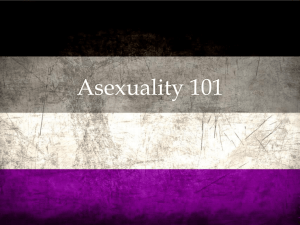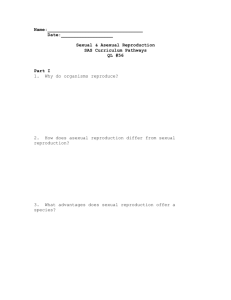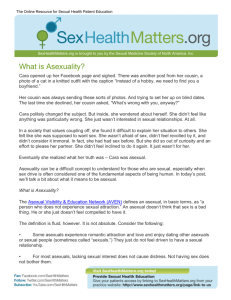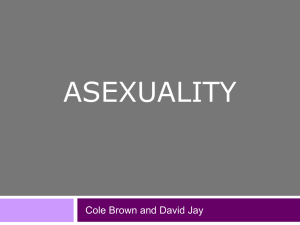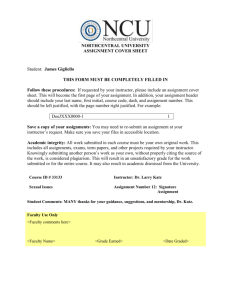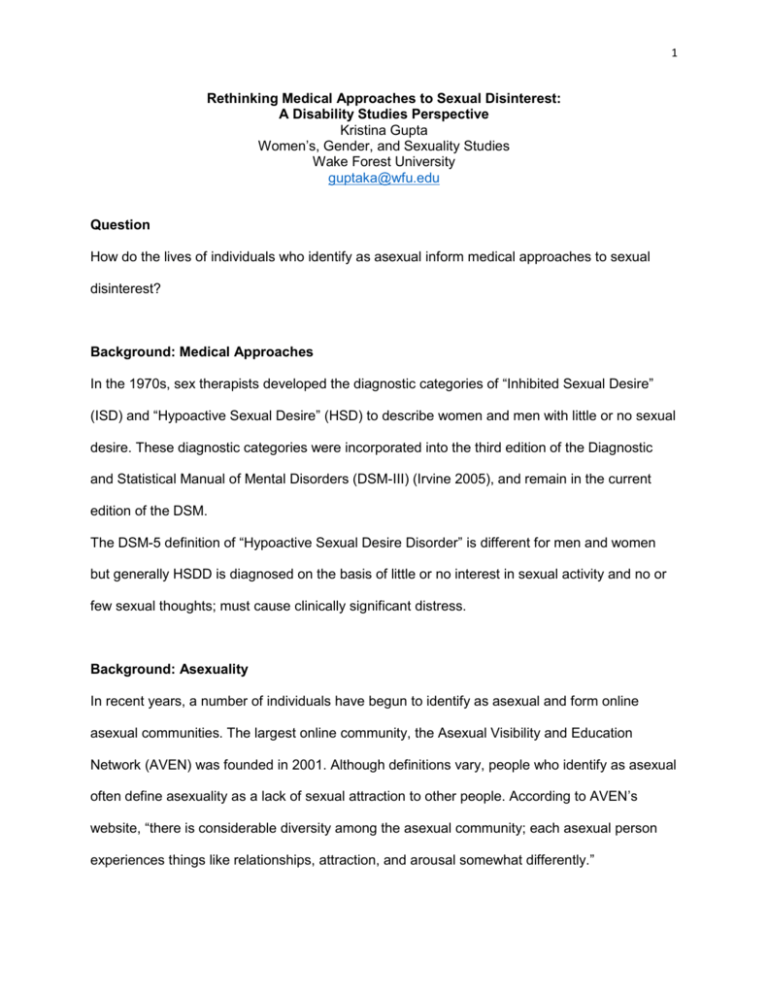
1
Rethinking Medical Approaches to Sexual Disinterest:
A Disability Studies Perspective
Kristina Gupta
Women’s, Gender, and Sexuality Studies
Wake Forest University
guptaka@wfu.edu
Question
How do the lives of individuals who identify as asexual inform medical approaches to sexual
disinterest?
Background: Medical Approaches
In the 1970s, sex therapists developed the diagnostic categories of “Inhibited Sexual Desire”
(ISD) and “Hypoactive Sexual Desire” (HSD) to describe women and men with little or no sexual
desire. These diagnostic categories were incorporated into the third edition of the Diagnostic
and Statistical Manual of Mental Disorders (DSM-III) (Irvine 2005), and remain in the current
edition of the DSM.
The DSM-5 definition of “Hypoactive Sexual Desire Disorder” is different for men and women
but generally HSDD is diagnosed on the basis of little or no interest in sexual activity and no or
few sexual thoughts; must cause clinically significant distress.
Background: Asexuality
In recent years, a number of individuals have begun to identify as asexual and form online
asexual communities. The largest online community, the Asexual Visibility and Education
Network (AVEN) was founded in 2001. Although definitions vary, people who identify as asexual
often define asexuality as a lack of sexual attraction to other people. According to AVEN’s
website, “there is considerable diversity among the asexual community; each asexual person
experiences things like relationships, attraction, and arousal somewhat differently.”
2
This Study
To find out how individuals who identify as asexual are affected by medical approaches to
sexual disinterest, I conducted thirty in-depth semi-structured interviews with self-identified
asexuals, recruited from AVEN. Twenty-five of the interviews were conducted in-person. The
other five interviews were conducted over the phone.
Key Findings
1. Asexual-identified individuals may experience distress as a result of stigma or pressure from
a partner. Many of my interviewees had found their lack of interest in sex to be distressing at
one time, because of stigma and/or because of the relationship difficulties it had created.
Around half of my interviewees reported some experience of pathologization – in other words, a
health professional, family member or friend had labeled them disordered even though they
themselves were satisfied with their level of sexual interest.
2. The line between HSDD and asexuality is not clear cut. As noted, many of my interviewees
experienced distress at some point. As a result, around one-third of my interviewees consulted
a health professional in an effort to find an explanation for their asexuality or in an effort to
increase their level of interest in sex. Most of these interviewees eventually decided not to
pursue these efforts, instead choosing to accept their level of interest in sex.
3. Asexuality can be a fulfilling way of being-in-the-world. Most of my interviewees rejected the
language of dysfunction to describe asexuality, instead talking about asexuality as simply a
different, and potentially fulfilling, way of being-in-the-world.
4. Despite reservations, almost all of my interviewees stated that individuals who are distressed
by their lack of interest in sex should be able to take on a diagnostic label like HSDD and seek
treatment if they so desire. Implicitly or explicitly, my interviewees accepted the possibility that
the availability of medical approaches might prevent people from coming to identify as asexual
or might lead people to give up the identity. A few interviewees were willing to allow people to
3
claim the label of asexuality and pursue a medical intervention to increase their level of sexual
interest at the same time.
Disability Studies
Since its inception, Disability Studies has combined a critique of the pathologization of bodily
variation with a recognition that many people with disabilities benefit from medical knowledge.
For example, Susan Wendell (1996) critiques the biomedical model of disability while calling for
medicine to focus less on controlling the body and more on improving the quality of patients’
experiences, helping people live with incurable physical limitations and suffering, and enabling
those who are fatally ill to die as well as possible (111). About the quest for a cure, she writes, “I
would joyfully accept a cure, but I do not need one” (84). This nuanced and complicated position
is echoed, in different ways, by other scholars in the field (Kafer 2013; Siebers 2008; Scully
2008).
Recommendations
Based on the experiences of asexual-identified individuals and the insights provided by disability
studies scholars, I offer the following recommendations:
1. Clinicians should work with clients who are distressed by low levels of sexual interest to
determine whether the label of “HSDD” or “asexual” (or neither or both) is best for them.
Clinicians should educate clients about both HSDD and asexuality, especially if the client’s
distress appears to be caused by the social stigmatization of asexuality.
2. Clinicians should recognize that some individuals who identify as asexual may be interested
in increasing their levels of sexual interest and this does not need to contradict their identity as
asexual. Clinicians should not police the boundaries of their clients’ asexuality.
3. If clients in a relationship are experiencing problems due to a discrepancy in levels of sexual
interest, the issue should be addressed as a relationship issue, not as the problem of one
4
particular person. The focus should be on improving communication, not on increasing levels of
sexual activity. While it may be helpful to work with one partner to increase their comfort with
sexual activity, it may also be helpful to work with another partner to change their expectations
about levels of sexual activity.
Sources
Asexual Visibility and Education Network (AVEN) <www.asexuality.org>
Irvine, Janice M. 2005. Disorders of Desire: Sexuality and Gender in Modern American
Sexology. Temple University Press.
Kafer, Alison. 2013. Feminist, Queer, Crip. Indiana University Press.
Scully, Jackie Leach. 2008. Disability Bioethics: Moral Bodies, Moral Difference. Rowman &
Littlefield.
Siebers, Tobin. 2008. Disability Theory. University of Michigan Press.
Wendell, Susan. 1996. The Rejected Body: Feminist Philosophical Reflections on Disability.
Psychology Press.

